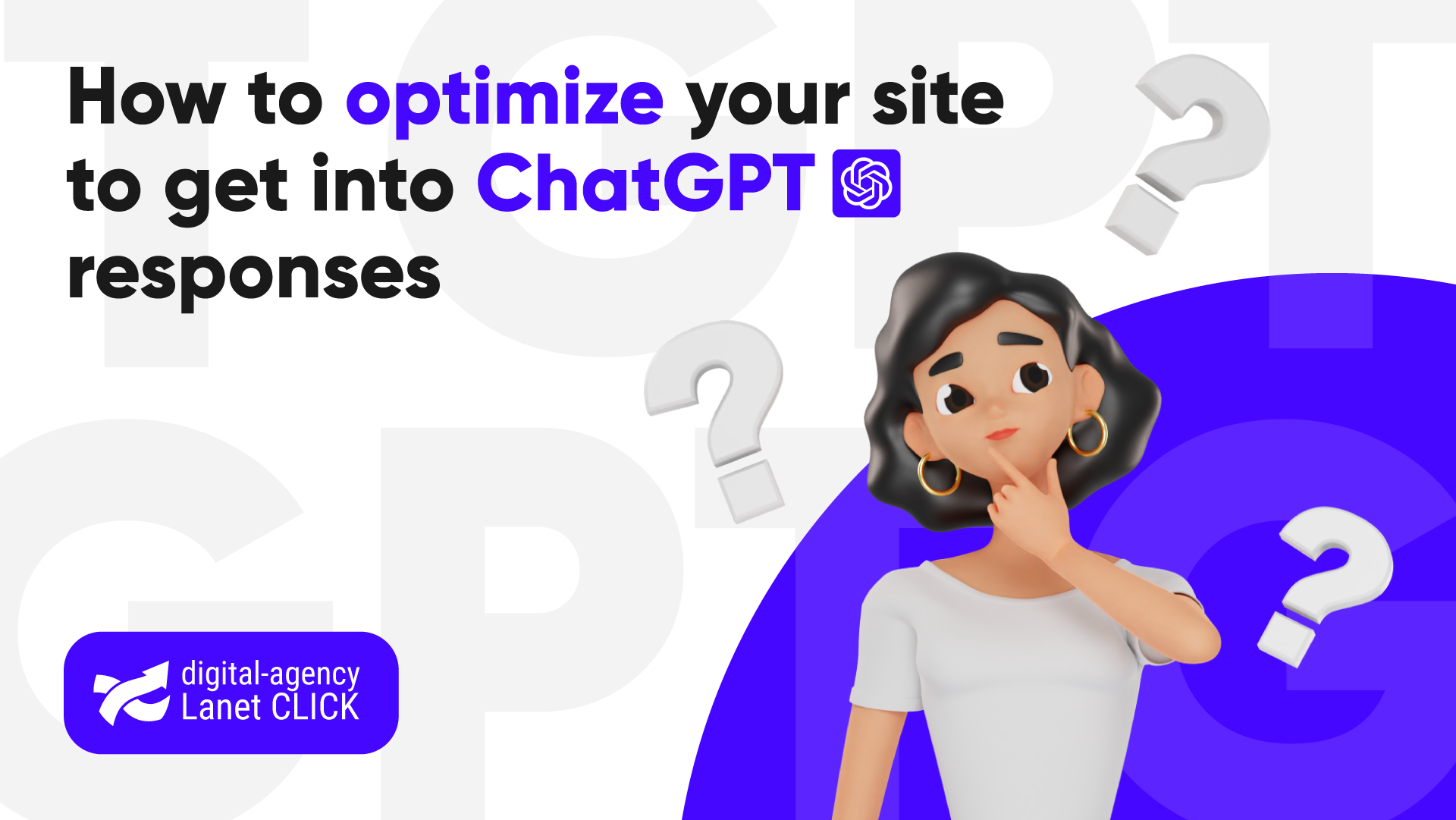
How to optimize your site to get into ChatGPT responses
Artificial intelligence has already changed the rules of the game in search engines. Users are increasingly turning to ChatGPT and […]

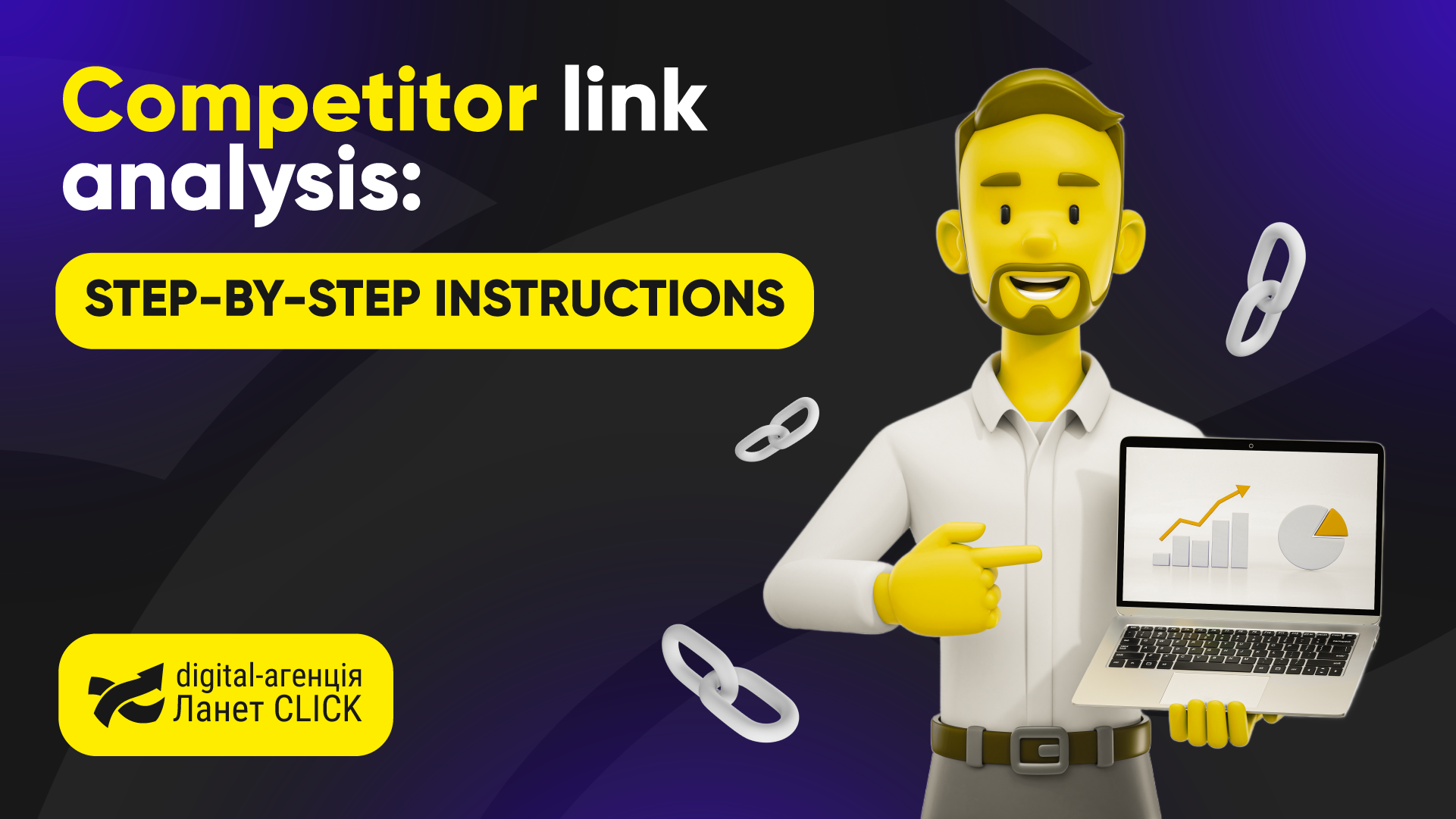
For a site to rank high in search results, it is important to work not only with content and technical optimization, but also with external links. To understand which links really affect the ranking and how to improve your own strategy, it is worth finding out the link mass of the competitor’s site and assessing the quality of the donors. This data helps to assess the strengths and weaknesses of the site, plan further steps and, if necessary, order SEO promotion from specialists at the Lanet CLICK agency.
A site’s link profile is a collection of all external links (backlinks) that lead to your resource and their characteristics: the number, quality of donors, anchor texts and technical attributes. Anchors show search engines what topics or keywords the link points to, and donors – the sites from which the links come.
The authority and relevance of donors determine the value of the link mass. That is why building a link profile should be systematic. To form an effective strategy, first analyze the links of competitors. It helps to understand which resources link to them, what link formats they use and how they develop their profile. You should also check the number of links to the site, assess their dynamics, types (dofollow/nofollow) and quality.
Through competitor research, you can identify effective methods for building link mass that will positively affect your site’s position.
Analyzing competitors’ backlinks helps:
Therefore, understanding the impact of link mass on site positions allows you to optimize your own SEO promotion strategy.
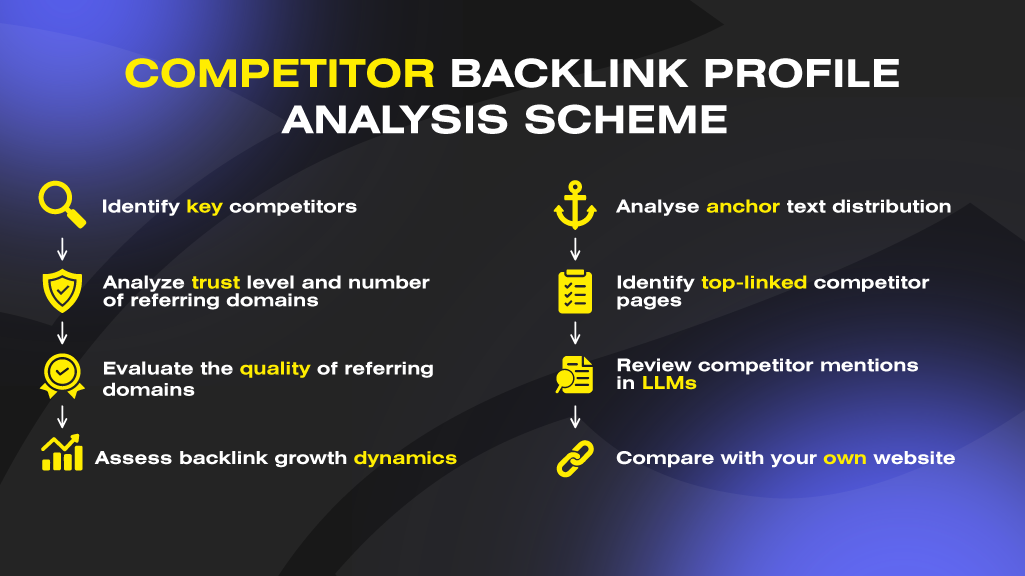
Analysis of the link profile of a site is a multi-stage process that requires a systematic approach. Each stage is responsible for a separate area, and only comprehensive work allows you to get a complete picture. It is important to analyze the external link mass regularly, because the market situation is changing rapidly, and the correctness of the decisions made depends on this.
First, you need to understand where to look at your competitors’ websites and see who exactly you are competing with in organic search. Often, business competitors do not match your real competitors in Google’s search results. Therefore, it is important to perform a manual search for key keywords and check the results using tools like Ahrefs or Serpstat.
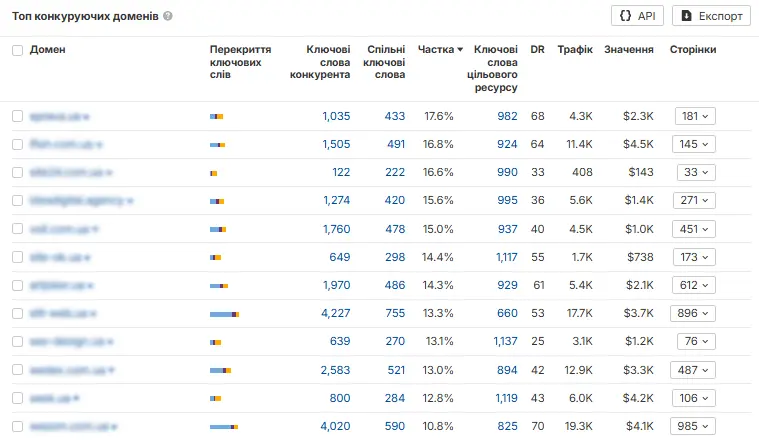
Next, you should assess not only the relevance to the topic, but also the scale of the business, volume, and traffic channels. It is imperative to determine the regionality of the site, because competitors in another country or region may have strategies that do not suit you. It will allow you to form a more realistic list of competitors for further analysis.
The next step is to assess the trustworthiness of competitors, that is, the level of trust of search engines in the resource. To analyze the trust of the site, the Domain Rating (DR) from Ahrefs and Domain Authority (DA) from Moz are used.
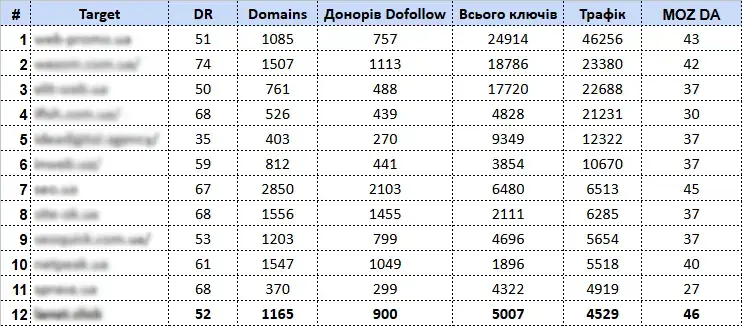
It is also important to collect data on the number of unique donors and the ratio of link types. To do it, you need to check dofollow and nofollow links and understand what balance will be natural in this niche. But how to find out the weight of a link if not all backlinks affect the ranking equally? To do it, the authority and relevance of donors are assessed. High-quality links from authoritative resources in the profile topic often have a much greater effect than dozens of secondary ones.
Domains can be classified by DR levels:
This distribution helps to understand the quality and strength of the competitor’s link base, as well as determine which types of donors you should target. Additionally, consider Majestic metrics – Trust Flow (quality) and Citation Flow (quantity) to assess the balance between quality and quantity of links: the proportion of TF to CF should be close to 1 or exceed 0.5 (formula TF/CF ≥0.5).
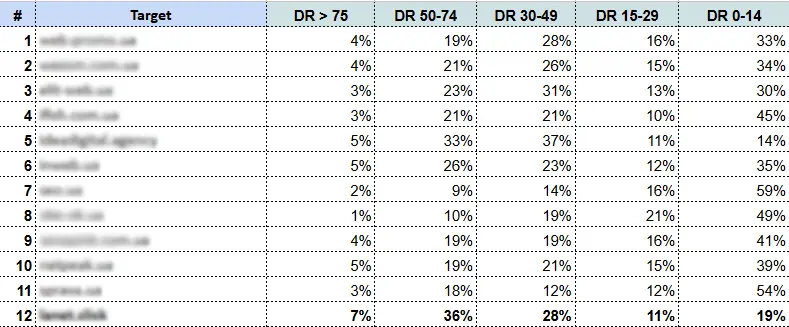
In order to distinguish trust donors from drops and PBN networks, an analysis of the competitor’s backlinks is conducted. Drops are former domains that have become free due to the expiration of the registration period and are now used for artificial weight redirection. They are most often used in PBN networks as satellite sites or to directly redirect link weight to the main resource via a 301 redirect. Competitor PBNs can be identified by searching for common owners through WHOIS services, Wayback Machine, and checking reciprocal links.
The profile must be dominated by natural link mass, not spam directories or link farms. A high-quality link strategy is always based on niche-relevant donors, so analyzing the site’s niche and checking the donor’s site’s authority are key. It is definitely worth checking the site for spam, because even a high DR does not guarantee value if the resource is oversaturated with outbound links. Spam also includes donors with low DR (0-14) from irrelevant regions (particularly Asia) or prohibited topics.
Evaluate the quality of donor domains by organic traffic, age, thematic and regional relevance, as well as the keywords they rank for. It is worth focusing on sites with real traffic of 10,000 users per month and stable growth dynamics.
The dynamics of the link mass show how quickly and steadily the backlink profile of competitors is growing. It is important to check the backlinks of the site not only for the number, but also for the growth rate. A sharp increase in external links in a short period may indicate a massive purchase of links, which arouses suspicion in search engines and leads to sanctions.

A gradual and stable increase in links to the site from month to month is considered optimal. Such dynamics are perceived as natural and help form a healthy link profile without risks.
When analyzing the purchase of links of a competitor, it is worth assessing how long it has been building links, when there were peak periods of activity and what average growth it had each month. It allows you to see the real growth strategy and determine how many links a site needs to build per month to gradually catch up with competitors without sharp jumps in statistics.
An anchor list is a set of texts that external links use to link to a website. They show search engines what queries a page is associated with. Analyzing incoming links to a website allows you to see which pages receive the most traffic through different types of anchors and how this affects the overall link profile.
To build an effective strategy, it is important to check your competitors’ link anchors and determine which types they use most often. The main types of anchors are:
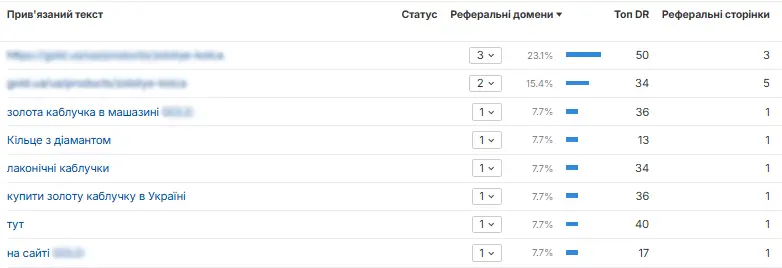
The optimal ratio of anchor and anchorless links depends on the topic and region of promotion, but the general guidelines are as follows: commercial anchors – 5-30%, mixed – 5-10%, anchorless – 10-20%, and the rest falls on the brand and URL.
Analysis of your competitor’s external links shows you which pages receive the most backlinks. These are usually the pages that generate the most conversions or are strategically important for promotion: product categories, landing pages, or informational articles. Understanding these priorities helps you determine which sections of your site should be linked to increase their visibility in search and increase the overall authority of the resource.
Mentions in generative search engines (LLM) are becoming an increasingly important visibility factor in modern SEO promotion of an online store, corporate website or any other web resource. Competent GEO promotion helps to optimize text for generative search and strengthen the brand’s presence in AI-answers.
To analyze competitors’ mentions in AI-answers, you can use the Ahrefs Brand Radar tool. It will help you track how often a brand is mentioned in LLM, such as ChatGPT or Perplexity, in what context and for what queries.
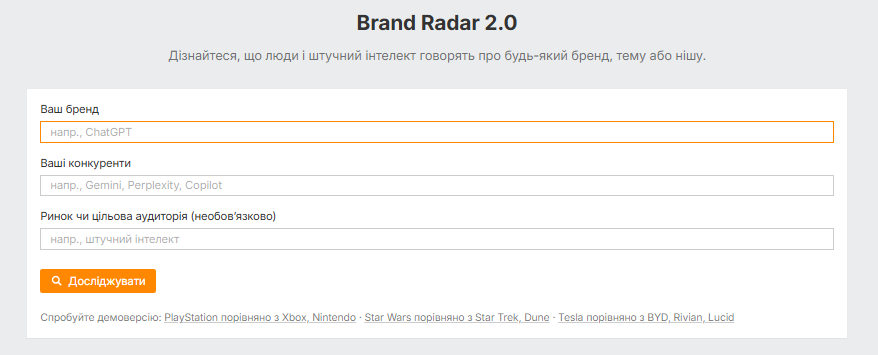
After conducting the analysis, it is important to compare the results with your own resource data. It will help to identify gaps in your link strategy, understand which types of donors or pages are undervalued, and identify potential growth points.
Use link-building strategies, focusing on the strengths of your competitors, but taking into account your own topics and goals. To do it, you should use data from Google Search Console – it will show which pages already have external links and which need to be strengthened. The table below will help you clearly compare the main indicators and determine the areas of further work.
| № | Site name | DR Ahrefs | MOZ DA | Number of donors | Dofollow donors | DR donor domains | Donor Domain Anchors | ||||||||
| > 75 | 50-74 | 30-49 | 15-29 | 0-14 | Anchors | Mixed | URL Anchors | Branded | Anchorless | ||||||
| 1 | Competitor 1 | 51 | 43 | 1085 | 70% | 4% | 19% | 28% | 16% | 33% | 16% | 10% | 14% | 48% | 12% |
| 2 | Competitor 2 | 74 | 42 | 1507 | 74% | 4% | 21% | 26% | 15% | 34% | 27% | 7% | 12% | 46% | 8% |
| 3 | Competitor 3 | 50 | 37 | 761 | 64% | 3% | 23% | 31% | 13% | 30% | 24% | 6% | 11% | 29% | 30% |
| 4 | Competitor 4 | 68 | 30 | 526 | 83% | 3% | 21% | 21% | 10% | 45% | 35% | 9% | 7% | 26% | 23% |
| 5 | Competitor 5 | 35 | 37 | 403 | 67% | 5% | 33% | 37% | 11% | 14% | 11% | 5% | 24% | 41% | 19% |
| Average value | 56 | 38 | 856 | 72% | 4% | 23% | 29% | 13% | 31% | 23% | 7% | 14% | 38% | 18% | |
| 6 | Own website | 39 | 27 | 512 | 54% | 2% | 25% | 27% | 12% | 35% | 44% | 2% | 18% | 9% | 27% |
Based on the analysis of the competitor profile, you can find almost all types of sources necessary for your own strategy: directories, media, blogs, forums and crowd-links. That is why it is so important to choose donors for links, taking into account their authority, topic and real audience activity. Some of these sites can be found on specialized exchanges, with others – to agree on direct placement, and some will remain inaccessible due to partner or closed agreements of competitors.
You should not completely copy their strategy, because this may look unnatural for search engines and not take into account the specifics of your business. It is better to increase the mass of links to the site, focusing on the quality of donors and the naturalness of the dynamics, taking into account the features of your site.
For the strategy to remain relevant, regular monitoring of backlinks from competitors and your own site is necessary. It will allow you to update the donor base and respond to changes promptly. Indexing of backlinks is no less important, because without it, the site will not get into Google. To do it, the owner of the donor domain must add a new page to the index via Google Search Console.
Even with access to modern tools, when auditing the link mass of competitors, businesses often make mistakes that reduce the accuracy of conclusions and the effectiveness of further strategy, including:
Read also: How to find out the site traffic
Analysis of the link mass of competitors is not a one-time action, but a continuous process that helps to remain among the leaders of search results. It forms a solid foundation for external optimization of the site. Understanding how to analyze the link profile of competitors allows you to find the strengths of their strategy, identify gaps in your own profile and adapt link mass growth strategies to the real needs of your own business.
Based on the analysis, you can determine the level of trust of competitors, which you should strive for, and compare it with your site. It allows you to better assess your own authority, determine priority pages for building link mass and adjust the distribution of anchors.
Combining this approach with other methods of internal and external optimization is a key element of comprehensive SEO promotion. It provides synergy between work with content, technical optimization and external signals, allowing not only to maintain the position of the site, but also to systematically increase its authority in search.

Artificial intelligence has already changed the rules of the game in search engines. Users are increasingly turning to ChatGPT and […]

Successful website operation starts not with design or content, but with choosing a hosting. It is the technical foundation that […]

In April 2025, TikTok resumed advertising for its first customer groups in Ukraine. After a hiatus caused by a full-scale […]
A good strategy, perfectly selected digital tools, and their effective application will allow the business to increase profits, grow the customer base, and form recognition and loyalty. Do you want something like that? Contact us.
You have taken the first step towards effective online marketing. Our managers will contact you and consult you soon.